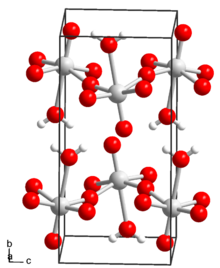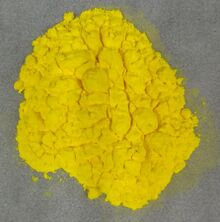Chemistry:Tungstic acid

| |

| |
| Names | |
|---|---|
| IUPAC name
Tungstic acid
| |
| Systematic IUPAC name
Dihydroxydioxotungsten | |
| Other names
Orthotungstic acid
| |
| Identifiers | |
3D model (JSmol)
|
|
| ChemSpider | |
| EC Number |
|
PubChem CID
|
|
| RTECS number |
|
| UNII | |
| |
| |
| Properties | |
| H2WO4 | |
| Molar mass | 249.853 g/mol |
| Appearance | yellow powder |
| Density | 5.59 g/cm3 |
| Melting point | 100 °C (212 °F; 373 K) (decomposes) |
| Boiling point | 1,473 °C (2,683 °F; 1,746 K) |
| insoluble | |
| Solubility | soluble in HF, ammonia slightly soluble in ethanol |
| Hazards | |
| NFPA 704 (fire diamond) | |
Except where otherwise noted, data are given for materials in their standard state (at 25 °C [77 °F], 100 kPa). | |
| Infobox references | |
Tungstic acid refers to hydrated forms of tungsten trioxide, WO3. Both a monohydrate (WO3·H2O) and hemihydrate (WO3·1/2 H2O)[1] are known. Molecular species akin to sulfuric acid, i.e. (HO)2WO2 are not observed.
The solid-state structure of WO3·H2O consists of layers of octahedrally coordinated WO5(H2O) units where 4 vertices are shared.[2] The dihydrate has the same layer structure with the extra H2O molecule intercalated.[2] The monohydrate is a yellow solid and insoluble in water. The classical name for this acid is 'acid of wolfram'. Salts of tungstic acid are tungstates.
The acid was discovered by Carl Wilhelm Scheele in 1781.[3]
Preparation
Tungstic acid is obtained by the action of strong acids on solutions of alkali metallic tungstates. It may also be prepared from the reaction between hydrogen carbonate and sodium tungstate. It can also be obtained from pure tungsten by reaction with hydrogen peroxide.[4]
Uses
It is used as a mordant and a dye in textiles.
References
- ↑ Günter, John R.; Amberg, Marcel; Schmalle, Helmut (1989). "Direct synthesis and single crystal structure determination of cubic pyrochlore-type tungsten trioxide hemihydrate, WO3 · 0.5H2O". Materials Research Bulletin 24 (3): 289–292. doi:10.1016/0025-5408(89)90214-6.
- ↑ 2.0 2.1 Wells, A.F. (1986). Structural inorganic chemistry (5th ed.). Oxford [Oxfordshire]: Clarendon Press. ISBN 0-19-855370-6.
- ↑ Scheele, Carl Wilhelm (1781) "Tungstens bestånds-delar" (Tungsten's [i.e., Scheelite's] constituents), Kungliga Vetenskaps Academiens Nya Handlingar (Royal Scientific Academy's New Proceedings), 2: 89–95. (in Swedish)
- ↑ Murau, P. C. (1961). "Dissolution of Tungsten by Hydrogen Peroxide". Analytical Chemistry. pp. 1125–1126. doi:10.1021/ac60176a021.
 |


